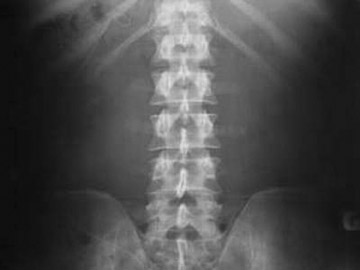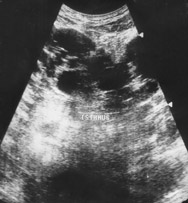Polycystic horseshoe kidney anomaly
Images



Polycystic horseshoe kidney anomaly.
Findings
The KUB showed lateral deviation of the JJ stent within the right ureter (Figure 1). CT kidney images showed fusion of the lower poles of the kidneys. The JJ stent was also visible in the right ureter (Figure 2). The ultrasound after stent removal showed multiple cysts in both kidneys as well as the isthmus. A large cyst containing a hematoma was visible in the left kidney (Figure 3).
Discussion
About 1 in 1000 individuals has some type of renal fusion, the most common being the horseshoe kidney. The incidence of horseshoe kidney is 1 in 400 to 1 in 800 people, and is more common in boys than girls.1,2 The two kidneys fuse across the midline,usually at their lower poles, by renal tissue or a fibrous band. The horseshoe kidney is usually lower than normal because the inferior mesenteric artery limits its ascent. It can also be malrotated and is prone to reflux, obstruction, infection and stone formation. The autosomal-dominant form of polycystic kidney disease (ADPKD) is an important cause of renal failure, accounting for 10% to 15% of patients who receive hemodialysis.4 The incidence of this anomaly ranges from 1 in 500 to 1 in 1000 cases. Because of the presence of multiple cysts, the diagnosis of hydronephrosis on ultrasound may be difficult. It is not uncommon for urologists to be involved in the care of patients with either adult polycystic kidney disease or horseshoe kidney disease. It is rare with incidence ranges of 1 in 134,000 to 1 in 8 million to have these 2 congenital disorders simultaneously in the same patient.2,3 Less than 20 cases have been reported in the literature.2,3
Patients with adult polycystic kidney disease, usually develop renal failure after 40 years of age. Co-occurrence of this disease with horseshoe anomaly may lower the age of renal failure and warrant closer follow-up for younger patients.
- Caglar K, Kibar Y,Tahmaz L, et al. Polycystic horseshoe kidney.Clin Nephrol. 2001;55:487-488.
- Brum FA, Becker M, Uglione A, Da Ros CT. Polycystic horseshoe kidney. J Urol. 1997;158:22-29.
- Trapp JD, Zukoski CF, Shelley HS, Goldner F Jr. Nephrectomy for polycystic horseshoe kidney with successful cadaver renal allograft. South Med J. 1965;58:1370-1371.
- Hildebrandt F. Genetic renal diseases in children. Curr Opin Pediatr. 1995;7:182-191.